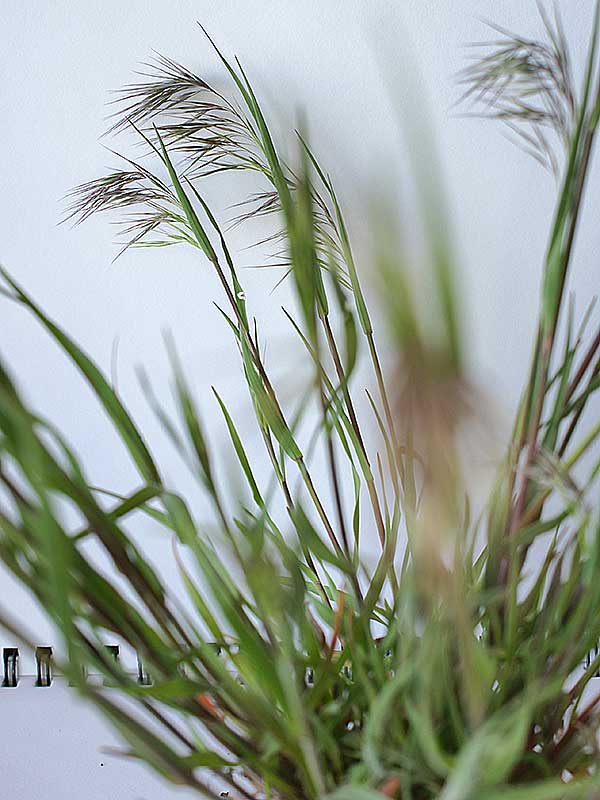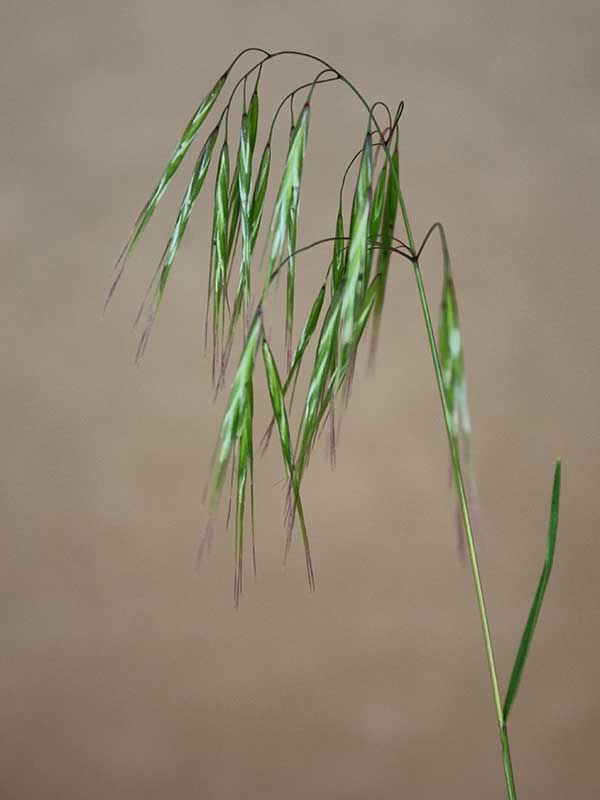Bromus tectorum / cheatgrass
- short bunchgrass, 2 to 30 in at floweirng
- panicle with all florets to one side; long awns
- early season growth, flowering, seed drop
- florets green, turning purple as seeds mature
- highly invasive!
Also known as: downy brome, June grass, drooping brome
Note: grasses have a nomenclature all their own, much different from that of dicots. A good resource/slide show from the University of Idaho on grass structures is available here.
Cheatgrass is a highly invasive, little-loved, winter annual weed. It is so bad that not even the weirdest of nurseries sell it as an ornamental. Cheatgrass seed arrived as contaminant in seed from western Asia. It was first reported in Pennsylvania in 1861. As the native sagebrush ecosystems of the west filled up with livestock, the (over) grazers damaged native communities, AND brought the cheatgrass seeds with them. Today, cheatgrass dominates more than 100 million acres in the Great Basin… n region that includes SE Idaho.
Cheatgrass plants range in height from 2 inches to 30 inches, and can flower at any size in that range. The plants have a shallow, fibrous root system and tillers range from upright in the center of a clump to almost flat to the ground (recumbent) farther out. the leaves are small and downy and it is often the case that the plants remain unnoticed until they produce their inflorescence.
Cheatgrass flowering stalks are open, drooping and highly branched panicles. Each spikelet contains 5 to 8 florets. At the tip of each are narrow awns, 5/8 inch long or longer. Expect all the spikelets to be on one side of the spike. The spikelets are green initially but turn purplish-red when the seeds are just mature. The seeds fall soon after that color change.
The seeds have long awns which attach to nearly everything they touch. This really facilitates the spread of cheatgrass. So if you go hiking or take your dog out for a walk in the forest and you come across one of those boot-cleaning stations, use it! Stop the spread of this and other invasive seeds.
Interesting bits – Many of the problems associated with cheatgrass invasions result from its life history strategy: it germinates in the fall, overwinters as a small plant, then grows fast in spring when soil moisture is highest. Then, it completes its life cycle and dries out within about 2 months. So basically, it has a get-in-fast-and-get-out lifestyle.
Because of that, it can outcompete almost all other plants, particularly after disturbances. And, it’s ready to burn when other grasses are getting started and unable to find water. Furthermore, it grows in very dense stands and has very fine stems and branches, and hairy seed heads. Thus, when fires come through, they carry really well. While native species may be adapted to fire, the hot, frequent fires that can be associated with cheatgrass are not what they signed up for.
Ecologically, cheatgrass is very widely adapted; it can grow basically anywhere except a permanently wet swamp or on soil which is both saline AND alkaline. As a result, cheatgrass can easily take over any habitat it gets into, no matter how poor the soil. This includes sagebrush communities throughout the west. Areas disturbed by human development, improper grazing or wildfire are excellent targets. Once established, it can quickly become the dominant species, to the point of monocultures. This reduces the quality of the habitat for practically all uses and alters the fire regime in a very negative way, leading, eventually, to even more monoculture.
Even if cheatgrass is eradicated from a landscape, native species may not recover even decades later. Partly this is because of the thick layer of dead grass – thatch – that the annual grasses produced. Besides keeping seedlings out, this also kills the lichens, mosses and cyanobacteria essential to the functioning of biological soil crusts.
| Color | |
|---|---|
| Family | |
| Inflorescence size | |
| Inflorescence type | |
| When? | |
| Where? |

